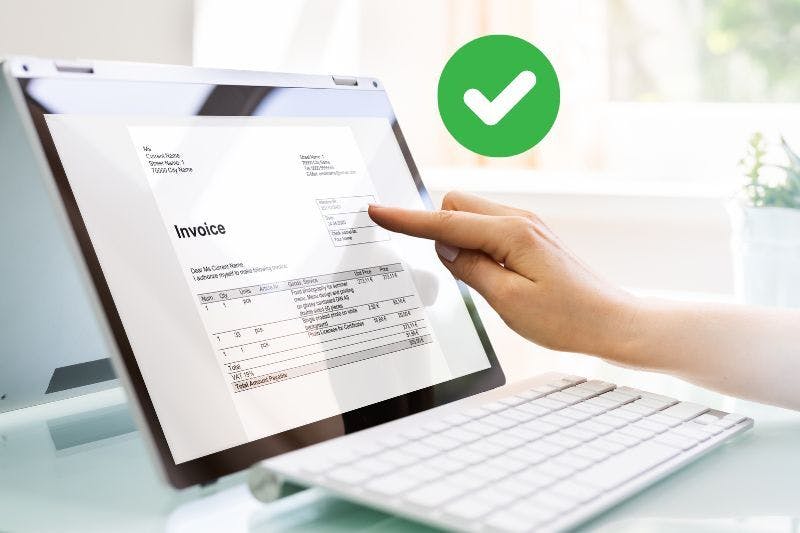
Getting paid on time is imperative for a healthy cash flow. And for a small business, overdue payments are not only a concern, but a real threat.
This is where effective accounts receivable management becomes the lifeline you need. In this article, we discuss 6 best practices that will help you smooth out your accounts receivable process and get you access to much needed funds.

Need help figuring AR out? Hall Accounting Company is happy to help small businesses set-up and implement accounts receivable collections.
Accounts receivable processes vary from company to company, however there are six best practices that every type of small business can implement immediately to improve cash flow. Let’s get started.
1. Establish a credit policy
Getting paid faster begins with establishing credit policies. Before you do any work or deliver goods, the questions about how you will extend credit should be clearly outlined in a written document.
You should ask all customers who want payment terms to complete an application, which will give you access to their basic company information and trade references. These references will tell you whether they are good payers.
This upfront kind of investigative work will save you a lot of heartache in the long run. Customers will see all the terms of your credit policy upfront and yes, it doesn’t mean they’ll comply with them all, but at least you will have set the foundation for further action if you do not get paid.
Here are some pointers for what you should put into your credit policy:
Decide who you will extend credit to. If a customer has a track record of poor debt settlement, you can request that they pay you upfront for goods or services.
Define a credit limit. When you speak to trade references, you can ask them how much credit the customer or company has with them. If they’ve never had a credit limit of more than, let’s say, $10,000, then learn from others.
Set clear payment terms.
Stipulate how you will pursue outstanding accounts.
2. Set clear payment terms
There’s a good reason we’ve pulled this one out for further discussion.
According to a LinkedIn article, payment delays are the second most commonly cited challenge for small businesses and have a significant or substantial impact on the business. [1] For this reason, accounts receivable management begins with setting clear payment terms. All payments depend on these terms.
In Texas, there is a law that governs the prompt payment of goods and services.[2] It states that you have 30 days to pay for goods/services from the date that the transaction is complete or the receipt of a correct invoice, whichever is later. Invoice refers to a vendor’s request for payment in this instance. Therefore, all your invoices must clearly stipulate that customer payments should be made within 30 days unless you have a cash-on-delivery stipulation.
Setting these payment terms gives you the starting point for receivables management, as this deadline dictates payment reminders sent to customers, notices sent for outstanding invoices and the management of outstanding debts (including legal steps).
Since the majority of your income will likely come from a small number of customers, each payment is essential for your bottom line. You can’t afford to have a large amount of money owed to you each month, so encourage customers to pay their invoices early by offering an early payment discount. You may feel you can’t afford to part with any funds; however, your bookkeeper or accountant can help you work out what these discounts should look like and how many of your customers are likely to use them.
Don’t have a bookkeeper or an accountant? You’re missing out on the benefits of outsourcing your bookkeeping.
2. Issue correct invoices

This may sound like a no-brainer, but you have no idea how many small businesses send out invoices with incorrect customer details, goods descriptions and invoice numbers. Yes, it’s true. Payment processing is severely delayed by incorrect invoices sent out to customers. The longer it takes to get the invoice correct, the longer it will take to collect payment.
This kind of thing is unnecessary in business. With so many excellent accounting software that allows you to issue invoices and even automate them, this can easily be corrected. All customer invoices should have the following basic information:
The correct invoice number
Business and contact details for both you and your customer
A description of goods/services which includes date and pricing information
Credit terms, along with the related due date and early payment discounts
Instructions on how to pay
3. Make it easy for customers to pay you
If you want to get your money quickly, make payment easy. Give your customers multiple payment options, such as ACH payments, checks, wire transfers, and credit cards. Nothing gets you paid faster than offering online payments. Some accounting software generates invoices with payment buttons that allow customers to pay the invoice directly.
For a small business, taking the time to work out how you can get paid more quickly could be the solution to poor cash flow as faster accounts receivable collections shorten the cycle.
Don’t give your customers a reason to delay payment.
We highly recommend these top four best practices for accounts receivable. You can make huge strides towards timely payments by implementing these best practices immediately. We can help you get on track by implementing top accounting software such as Xero, Intuit QuickBooks, Gusto, Bill.com and others. This will ensure you issue 100% correct invoices and provide you with multiple gateways for collecting payment.
Now that we have the four most important receivable best practices behind us, let’s continue. The remaining best practices will boost the efficiency of your AR management even more.
4. Manage customer relationships

Image courtesy of Canva/Getty Images
Most of your late payments can be effectively managed by enhancing your customer relationships. Building a good reputation for delivering outstanding goods/services is one thing, but you also need to have the same dedication to customer satisfaction. When the financial health of your business depends on these relationships, you have all the incentive you need to focus on building sound business relationships.
Let’s face it: when you’ve invested time and money into building up a good rapport with your customers, they are less likely to leave you with unpaid invoices unless, of course, they’re having a financial issue.
Even when you do run into snags, you’ll be able to communicate openly with your customers about overdue accounts.
According to an article by Entrepreneur the average small business in the United States has $84,000 in unpaid invoices with many of these taking longer than 30 days to collect. They also noted that most small businesses only have 27 days of cash reserves. Risky stuff.
Customer relationship management takes time, but while you’re spending that time collecting outstanding debts, you can’t focus on this core business function. We say, ‘Get back to doing what you love,’ and let us help you with your credit policies, collecting payments, online payment options and collections process.

Get help managing your AR process
5. Issue monthly statements
A Statement of Account is a friendly reminder to customers about the status of their accounts. A statement shows all transactions and the total invoiced to the customer for a particular date range. It also shows the payments made by the customer and what is outstanding at the end of a specific period, e.g., 30 days, 60 days, 90 days. The important thing is that you consistently follow the accounting method your determine whether it is based on cash or accrual.
Unfortunately, a large number of debtors will wait for the statement of account to arrive before settling outstanding amounts. This kind of information coming from these statements is important for small businesses because it allows you to forecast your cash flow. For example, you may need to invest some money in buying goods from a supplier. You need to know when you can expect the money to be in your bank account before committing to the purchase.
Don’t despair if this sounds complicated. Some software like Intuit QuickBooks will allow you to automatically email statements to customers on a monthly basis. We’ll discuss this kind of automation a bit later. Also, if you’ve signed up for bookkeeping or accounting services then they can set this up for you.
I want to sign up for business bookkeeping services.
6. Actively manage ‘past due’ invoices

Image courtesy of Canva/Getty Images Signature
The previous point flows nicely into this one. This is about what you’re going to do when invoices and statements are being ignored. Rather than being caught off guard by a massive bad debt, you should actively manage late payments. This is a monthly task and you can use an accounts receivable aging report.
An aging report shows the relationship between unpaid invoices and their respective due dates. It’s called this because the accounts receivables are broken down into age categories. While statements go to individual customers, this report is a breakdown of all outstanding debtor accounts for your business.
How can you use an aging report?
The aging report gives you the power to make important business decisions regarding your future AR processes. Here are just a few ways this report can impact your decisions.
Use the report to adjust your credit policy. If one customer owes you a great deal of money, you need to take action to collect that money. However, if a few customers are paying for more than 60 days, this may be a signal that your credit policy is not tight enough or that you are not actively calling them about late payments.
It helps you to identify potential cash flow problems.
You can forecast potential losses and make allowance for those losses.
The fact is that your customers are managing their finances as well. Whether they are individuals or companies, they will be juggling their budget to pay you when it suits them. You have to let them know through the active management of accounts receivables that they will be hearing from you one way or another when their payments are late.
Alright, let’s wrap this up.
For small businesses, managing accounts receivable is absolutely key to maintaining a healthy cash flow. Let’s say this: It’s keeping your company’s heart beating.
By immediately implementing the best practices that we’ve discussed in this article - like setting clear credit terms from the start, making sure your invoices are spot-on, and giving your customers plenty of payment options - you can really speed up those payments.
Plus, don’t underestimate the power of good customer relationships. Staying connected to your customers can make a huge difference when it comes to getting those invoices cleared. Staying ahead of the game is what you need to do, and that can only be achieved by keeping an eye on overdue accounts.
In essence our recommendations are aimed at not only boosting your cash flow, but building an AR process that will serve your business objectives. If you're having trouble collecting, we can also help you manage your past-due invoices with the correct write off process for the best possible tax implications.
We know what makes the heart of small businesses beat because we are one. If you want a partner who can help you streamline and manage your accounts receivable, you’re looking at us!
We will help you put all these best practices in place in a relatively short time. We not only provide you with reports such as the accounts receivable aging report but we can also advise what you should do with the information.
We say ‘Get back to doing what you love’ and we’ll handle the accounting. Doesn’t that sound like a good plan?
SCHEDULE A CALL TODAY
References:
1. Payment delays a top concern for small businesses